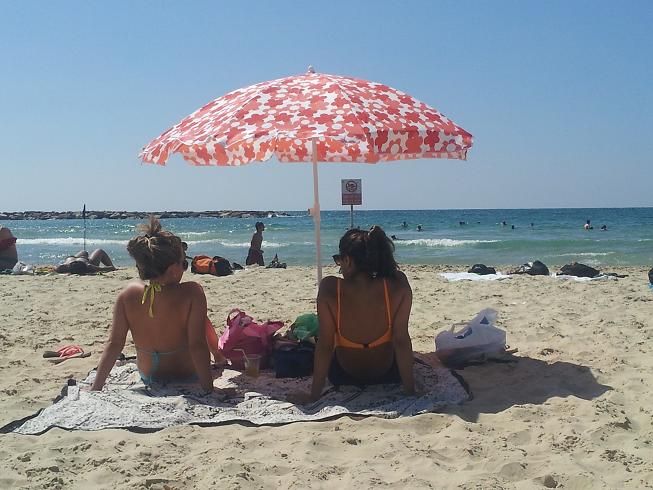Check out our shop where you can purchase tours! Learn More
What stands out most about Tel Aviv is that it’s not Jerusalem.
You won’t find two cities anywhere that are so close – only 60 kilometers (37 miles) apart – yet so different from one another.
Jerusalem was built thousands of years ago on the rocky terrain of hilltops; Tel Aviv just a century ago on sandy dunes along the beach.
Jerusalem is one of Israel’s poorest cities; Tel Aviv one of its richest.
Jerusalem is Israel’s political and religious center; Tel Aviv its economic and commercial hub.
And the differences continue: Jerusalem has extreme religious elements, while Tel Aviv was voted one of the “best gay cities” by the LGBT community. Jerusalem is a city of the past, while Tel Aviv lives in the present.
But Tel Aviv isn’t just the antithesis of Jerusalem.
It’s also a city that can stand on its own and boasts a large variety of sights, such as the Old City of Jaffa, (the official name is Tel Aviv-Jaffa), magnificent Bauhaus architecture, first-rate museums, and colorful open-air markets.
Akiva Weiss, one of the founders of Tel Aviv wrote in 1906, three years before the first house was built: “And like the city of New York symbolizes the main gate of entry to America, so we must refine our city, and one of these days, it will be the New York of the Land of Israel.” In less than a hundred years, Akiva Weiss’s vision of Tel Aviv has become reality.

Population: 420,000 but with Gush Dan, the Tel Aviv Metropolitan Area, the population is 3.5 million
Internet access: Free Wi-Fi in every hotel, hostel, and café, and there are 60 Wi-Fi hot spots around the city
Banks and ATMs: easy to find
Tel Aviv, as I have written, is very different then Jerusalem, also in terms of sights. Here there is no Wailing Wall, no Church of the Holy Sepulcher, nothing that you absolutely must see. You can relax and lay on the beach the whole day. If you do want to do some sightseeing, and I truly recommend that you do, these are the main ones:
Jaffa – Jaffa visitor center at Kedumim Square, Jaffa’s flea market, Jaffa Port, St. Peter’s Church
South Tel Aviv – American Colony, Neve Tzedek, Hatachana (Jaffa’s old railway station)
Tel Aviv – The Promenade, Sarona, Rabin Square, Independent Hall, Tel Aviv Museum of Arts, Eretz Israel Museum
Inside Tel Aviv:
Walking: Always the best way to get to know a city. Tel Aviv is flat and relative small.
Car: Try to avoid driving inside the city. The one-way streets and trying to find parking will make you go crazy. Rent a car only if you want to drive out of the city.
Bicycle: One of the most successful public transportation projects in the last years is the Tel-O-Fun green bicycles. Day rental costs NIS 17 (23 on weekends and holidays). Each ride is limited to 30 minutes. Payment is only possible with credit card.
Buses: Buses are a good way to get around. Though many of the drivers don’t speak English, you’ll always find an English-speaking Israeli passenger who will be willing to help you. You can purchase your ticket from the driver. Public transportation does not run from Friday afternoon until Saturday night and on Jewish holidays. NIS 6.90 is the price for one city ride. http://www.bus.co.il/otobusimmvc/en
Monit Sherut (service or public taxi): Taxi for 10 passengers. They follow the routes of main bus lines and are a little cheaper. Run 24/7, also on Saturday and Jewish holidays.
Taxis: Taxis are the quickest way to get from place to place. Unfortunately, on tourist satisfaction surveys carried out by the Ministry of Tourism, taxi drivers received the lowest score – mostly due to cigarette smell, poor English, and exorbitant prices. Ask your driver to turn on the “mone” (meter). It’s required by law.
Getting around on Saturdays: There are no buses, but the sherut taxis still run.
Distances:
Tel Aviv to Jerusalem – 70 km (43 miles), about an hour drive
Tel Aviv to Haifa – 95 km (59 miles), about an hour-and-a-half drive
Tel Aviv to Ben Gurion Airport – 15 km (9 miles), about a 30-minute drive.
Tel Aviv to Masada – 161 km (100 miles) about a two-hour drive
To/From Jerusalem: It’s embarrassing but true: there is no express train to Jerusalem. This is supposed to change in 2017. Until then, you’ll have to rely on buses, shared taxis, and regular taxis.
Bus 405 – Tel Aviv Central Bus Station to Jerusalem Central Bus Station. Departs every fifteen minutes. Tel Aviv’s central bus station is located in the southern part of the city, which is a less pleasant place to stroll around at night.
Bus 480 – Tel Aviv Arlozorov (also known as Savidor Center, and 2000 Terminal) to Jerusalem Central Bus Station. Departs every ten minutes.
On Saturdays: There are shared taxis to Jerusalem which depart outside the central bus station to Goldman square (or Efrayim Di-Zahav Square) on the Hanevi’im St. and Monbaz Zmora St. junction.
To/From Haifa: trains run regularly to Haifa (and north to Akko).
To/From Ben-Gurion Airport: trains run regularly to the Airport.
Galilee – There are buses to all the major cities in northern Israel – Kiryat Shmona, Tiberias, Safed from Central Bus Station, Most of the buses stop also at Arlozorov Terminal next to Savidor Railway Station.
Be’er Sheva – Trains run regularly to Be’er Sheva.
Eilat – Buses run regularly to Eilat. In summer and holidays it is advisable to buy a ticket in advance.
…
+ Discount Codes
…or as a PDF